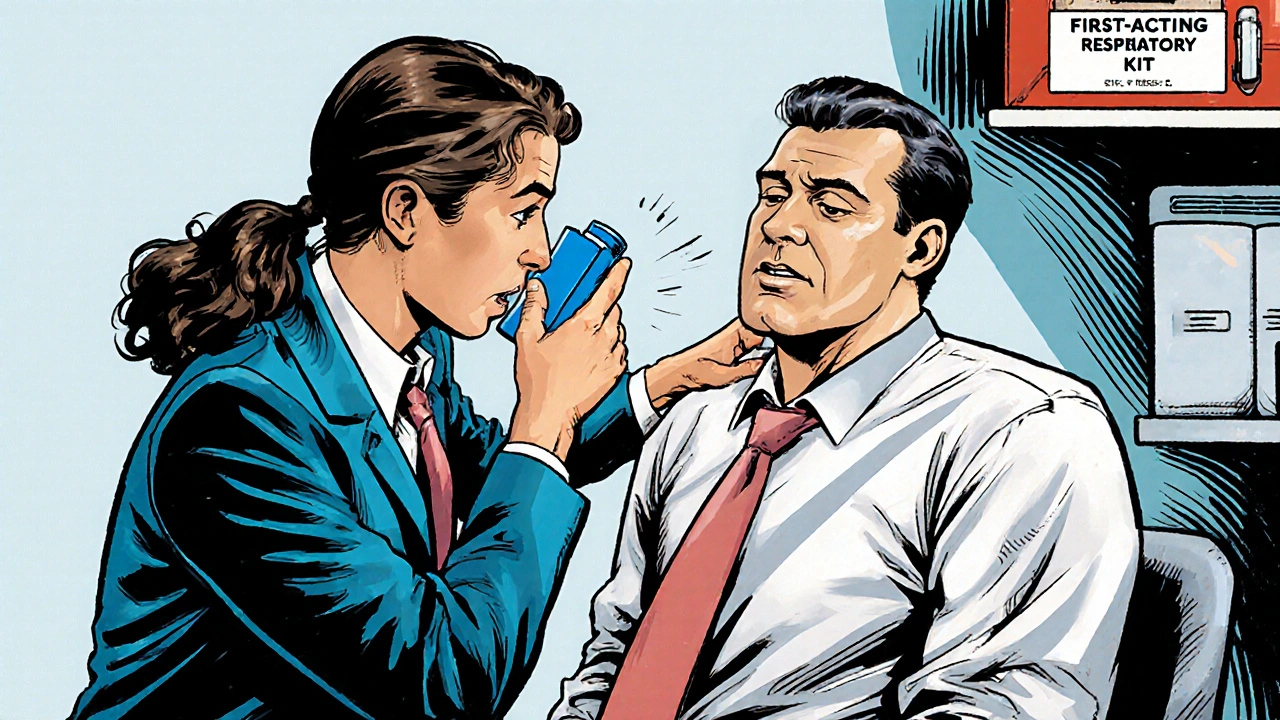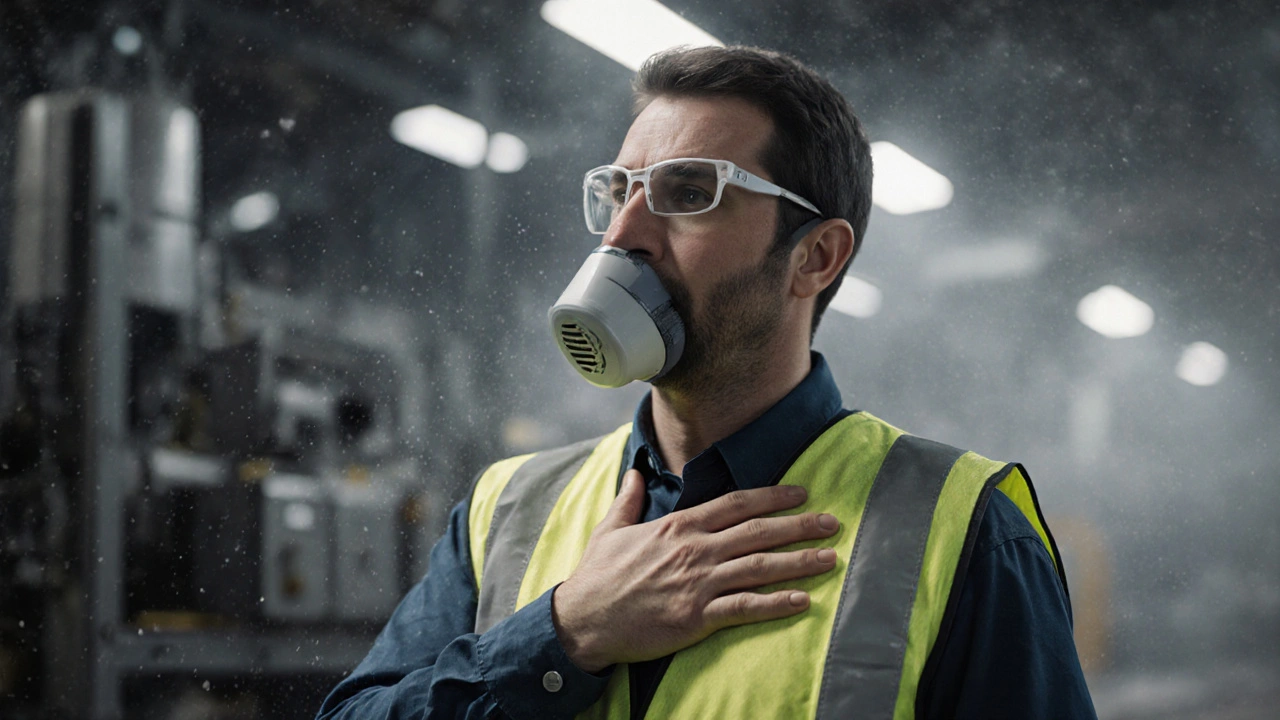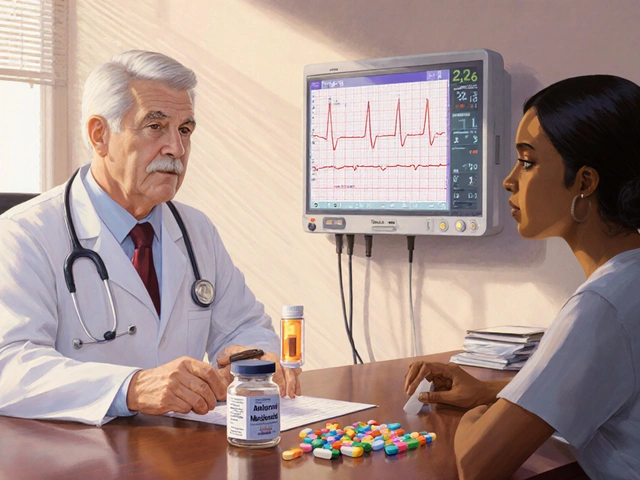Workplace Respiratory Kit Calculator
Emergency Equipment Requirements
Based on OSHA guidelines and the article's recommendations for workplace bronchospasm management
Recommended Equipment
Short-Acting Inhalers:
Nebulizer Kits:
Location:
OSHA Compliance Note: Ensure all equipment is inspected monthly and replaced before expiration. Maintain emergency kits in clearly marked locations.
When an employee suddenly struggles to breathe at work, every second counts. Knowing how to spot and treat bronchospasm management can mean the difference between a quick recovery and a serious emergency.
Understanding Bronchospasm in the Workplace
Bronchospasm is a sudden tightening of the smooth muscles surrounding the airways that limits airflow and causes wheezing, coughing, and shortness of breath. It often occurs in people with asthma, but workplace irritants-dust, chemicals, fumes, or extreme temperatures-can trigger it even in those without a prior diagnosis.
Another key term you’ll hear is Occupational asthma, a form of asthma that develops or worsens because of exposure to specific workplace agents. While bronchospasm is an acute event, occupational asthma describes the longer‑term condition that makes those acute episodes more likely.
Recognizing the connection between environment and airway reactivity helps managers create safer spaces and empowers coworkers to act fast when an episode starts.
Early Warning Signs Employees Should Know
- Sudden tightness in the chest or throat
- Wheezing or a high‑pitched whistling sound when breathing
- Persistent cough that doesn’t improve after a few minutes
- Shortness of breath, especially during physical tasks
- Feeling of “air not getting in” despite trying to breathe deeper
If any of these symptoms appear, the employee should alert a supervisor or designated safety officer immediately. Prompt reporting shortens response time and reduces the risk of severe hypoxia.
Immediate Response Steps
- Stay calm and reassure the affected person.
- Help the employee sit upright; a leaning‑forward position eases airflow.
- Check if they carry a prescribed short‑acting bronchodilator inhaler (e.g., albuterol). If yes, guide them to use two puffs, waiting one minute between puffs.
- If no personal inhaler is available, retrieve the workplace‑provided inhaler or nebulizer from the first‑aid respiratory kit. Administer as instructed on the label.
- Monitor breathing every 30 seconds. If symptoms persist after the second puff or nebulizer treatment, call emergency services (911 in the U.S.) and notify on‑site medical personnel.
Document the incident right away-date, time, trigger, actions taken-so occupational health can track patterns and adjust controls.

Medications & Equipment Every Workplace Should Have
While personal inhalers are ideal, employers are legally required in many regions to provide emergency respiratory aid for workers at risk. The following items cover most scenarios:
| Device | Typical Drug | Onset (minutes) | Portability | Best Use Case |
|---|---|---|---|---|
| Metered‑dose inhaler (MDI) | Albuterol (100µg per puff) | 2-5 | High - fits in a pocket | Quick relief for known asthmatics |
| Nebulizer | d>Albuterol solution (2.5mg) | 5-10 | Low - requires power source | Severe attacks or when inhaler technique is poor |
| Combination inhaler (SABA + corticosteroid) | Formoterol + Budesonide | 4-6 | Medium - larger than MDI | Both acute relief and inflammation control |
Training staff on proper inhaler technique-especially the “hold‑to‑inhale” method-reduces wasted doses and improves outcomes.
Creating an Emergency Action Plan (EAP)
An EAP is a written, step‑by‑step protocol that outlines who does what when bronchospasm strikes. Essential components include:
- Designated responders: Identify at least two employees trained in first aid respiratory care.
- Equipment locations: Map the nearest inhaler, nebulizer, and oxygen source on each floor plan.
- Communication flow: Provide a clear chain-employee → supervisor → onsite medical staff → emergency services.
- Documentation form: Record trigger, symptoms, interventions, and follow‑up recommendations.
- Review schedule: Update the plan annually or after any incident.
Share the EAP during onboarding and conduct quarterly drills so everyone knows their role before a real emergency.
Training, Education, and Prevention
Prevention starts with reducing exposure:
- Implement local exhaust ventilation for dust‑producing processes.
- Provide personal protective equipment (PPE) such as respirators when chemicals are present.
- Schedule regular air‑quality monitoring; maintain humidity between 30‑50% to keep airways moist.
Education goes hand‑in‑hand with equipment. Consider these training touchpoints:
- Monthly short sessions on recognizing early bronchospasm symptoms.
- Hands‑on practice with inhalers and nebulizers using simulation kits.
- Review of the EAP and role‑playing scenarios for supervisors.
When employees understand both the “why” and the “how,” they’re more likely to intervene early and avoid escalation.

Legal and Regulatory Considerations
In the United States, the Occupational Safety and Health Administration (OSHA) mandates that employers provide a safe workplace, which includes controlling respiratory hazards and having emergency response equipment. Similar regulations exist in the EU (Directive 2004/37/EC) and Canada (Canada Labour Code).
Key compliance checkpoints:
- Conduct a formal respiratory hazard assessment every two years.
- Document availability of emergency bronchodilators and training records.
- Report any work‑related respiratory illness to the relevant occupational health authority within the statutory timeframe.
Non‑compliance can lead to fines, workers’ compensation claims, and damage to company reputation.
Quick Checklist for Managers
- Identify high‑risk areas (e.g., paint booths, grain silos).
- Stock at least one short‑acting inhaler per 25 employees in those zones.
- Post clear signage indicating where respiratory kits are located.
- Train all staff on the three‑step emergency response: sit upright, use inhaler, call for help.
- Review air‑quality data weekly; adjust ventilation as needed.
- Update the Emergency Action Plan after every incident.
Frequently Asked Questions
What’s the difference between an inhaler and a nebulizer?
An inhaler delivers a measured dose of medication in a quick puff, ideal for fast relief and portability. A nebulizer turns liquid medication into a fine mist over several minutes, useful for severe attacks or when the patient has trouble coordinating inhaler use.
How often should workplace respiratory equipment be inspected?
Inspect inhalers for expired dates and check nebulizer batteries or power sources monthly. A full audit of all emergency respiratory kits should happen quarterly.
Can I use over‑the‑counter inhalers for workplace emergencies?
Over‑the‑counter products are generally not formulated for acute bronchospasm relief. Only prescription‑grade short‑acting beta‑agonists (e.g., albuterol) should be stocked for emergencies.
What legal steps must I take after an employee suffers a bronchospasm at work?
Record the incident in the OSHA 300 log (or local equivalent), report any work‑related respiratory illness to the appropriate authority, and review the Emergency Action Plan for gaps.
How can I reduce the risk of bronchospasm triggers in a manufacturing setting?
Install local exhaust ventilation, use low‑dust raw materials, provide compatible respirators, and conduct routine air‑quality monitoring. Training employees to recognize and report irritants also cuts risk.







Rich Martin
October 12, 2025 AT 20:55Set up dedicated inhaler stations in every high‑risk zone now-waiting for an asthma attack to prove the need costs lives and fines.
Buddy Sloan
October 14, 2025 AT 14:35Got it, thanks for the heads‑up! 😊
Deidra Moran
October 16, 2025 AT 08:15It is astonishing how corporate safety manuals continue to relegate respiratory emergencies to a footnote, as if the specter of bronchospasm were a myth concocted by overzealous health officers. The underlying assumption appears to be that workers will simply ignore irritants until they collapse, a narrative that conveniently absolves management of liability. Yet the data from industrial hygiene surveys unequivocally demonstrate a correlation between particulate exposure and acute airway constriction. One must therefore question why the procurement process still favors generic over‑the‑counter inhalers, despite clear evidence that prescription‑grade bronchodilators are the only effective rescue agents. Moreover, the prescribed quarterly audits are often reduced to a perfunctory checkbox exercise, detached from any real risk assessment. The veneer of compliance masks a deeper structural failure: an industry that prefers to conceal occupational hazards behind layers of bureaucracy. By insisting on surface‑level training without addressing the root causes-ventilation, material substitution, and continuous monitoring-the system perpetuates a false sense of security. In short, the current paradigm is a house of cards waiting to collapse under the weight of an unaddressed respiratory incident.
Zuber Zuberkhan
October 18, 2025 AT 01:55Absolutely, a proactive stance on ventilation and real‑time air monitoring can bridge that gap and turn policies into practice.
Tara Newen
October 19, 2025 AT 19:35The checklist you posted reads like a generic corporate memo; any serious safety officer would tailor it to the specific hazards of their plant.
Amanda Devik
October 21, 2025 AT 13:15Love the focus on PPE integration and respirator fit‑testing – it’s the cornerstone of occupational health engineering and ensures compliance without sacrificing worker morale.
Mr. Zadé Moore
October 23, 2025 AT 06:55Half the recommendations are redundant; streamline to inhaler per 25 staff and monthly device checks.
Brooke Bevins
October 25, 2025 AT 00:35Redundancy breeds complacency, not safety. 😠
Vandita Shukla
October 26, 2025 AT 17:15When you examine the particulate size distribution in grain silos, you’ll notice that particles under 10 µm can penetrate deep into the bronchi, triggering hyper‑responsiveness even in asymptomatic workers. This fact alone justifies the allocation of nebulizer units in addition to MDIs, because nebulizers can deliver higher aerosol concentrations over a sustained period. Moreover, the OSHA standard 1910.94 explicitly mandates engineering controls for airborne contaminants, which many facilities interpret too loosely. By installing localized exhaust hoods at the source, you reduce ambient concentrations by up to 85 %, dramatically lowering the incidence of bronchospasm episodes. Finally, the documentation protocol should include a timestamped log of each exposure event, cross‑referenced with spirometry baselines to track longitudinal lung function trends.
Samantha Gavrin
October 28, 2025 AT 10:55Sure, as long as the “engineered controls” aren’t just a front for cutting worker benefits while pretending to comply.
NIck Brown
October 30, 2025 AT 04:35Great rundown! This is exactly the kind of practical guide we need on the floor.
Andy McCullough
October 31, 2025 AT 22:15From an industrial hygiene perspective, integrating real‑time particulate monitors with a cloud‑based alert system allows supervisors to trigger emergency response protocols the moment concentrations exceed threshold values. Coupling that with automated inventory tracking of albuterol MDIs ensures kits are never out of stock. Additionally, consider embedding QR codes on kit signage that link to video tutorials on correct inhaler technique, reducing user error in high‑stress scenarios.
Zackery Brinkley
November 2, 2025 AT 15:55Clear steps, easy to follow – well done.
Laura Barney
November 4, 2025 AT 09:35Picture this: a bright red inhaler perched on a polished steel cabinet, a neon sign flashing “Breathe Easy Here,” and every worker knowing exactly where to go when the air turns sour. That visual cue alone can cut response time in half.
Jessica H.
November 6, 2025 AT 03:15The procedural outline adheres to OSHA 1910.38 requirements; however, the documentation language should be standardized to align with ISO 45001 terminology for consistency across multinational sites.
Ted Whiteman
November 7, 2025 AT 20:55Honestly, if you’re still counting inhalers per employee, you’re living in the Stone Age – the future is smart sensors that detect bronchoconstriction before it even starts.
Reynolds Boone
November 9, 2025 AT 14:35Could anyone share how they’ve integrated smart wearables into their respiratory emergency plans?
Angelina Wong
November 11, 2025 AT 08:15Smart wearables are still costly but piloting them in high‑risk units shows promise.
Anthony Burchell
November 13, 2025 AT 01:55Friendly reminder: adding more tech won’t help if the staff never practice the drills; keep the basics sharp.
Michelle Thibodeau
November 14, 2025 AT 19:35When you stroll through a bustling manufacturing floor, the subtle hum of machinery often drowns out the far more insidious whisper of airborne irritants that linger in corners and crevices. These microscopic trespassers, invisible to the naked eye, possess the uncanny ability to infiltrate the delicate linings of our airways, setting the stage for a cascade of bronchospastic events that can erupt without warning. The most effective antidote, however, is not merely a stash of inhalers and nebulizers tucked away in steel cabinets, but a comprehensive ecosystem that marries engineering controls, vigilant monitoring, and relentless education. First, by deploying high‑efficiency particulate air (HEPA) filtration units directly at the source of dust generation, facilities can curtail the initial surge of particulate matter by upwards of ninety percent. Second, continuous real‑time air‑quality sensors, calibrated to detect volatile organic compounds (VOCs) and particulate concentrations, feed data into a centralized dashboard that alerts supervisors the instant thresholds are breached. Third, periodic refresher workshops that employ hands‑on simulation kits empower workers to master the “hold‑to‑inhake” technique, turning a potentially panicked gasp into a measured, therapeutic breath. Moreover, integrating these simulations with virtual reality scenarios can immerse employees in realistic emergency drills without exposing them to actual hazards. Documentation, too, should evolve beyond a static log; a dynamic electronic health record (EHR) linked to each incident can track recovery trajectories, uncover patterns, and inform targeted interventions. Finally, leadership must champion a culture where respiratory safety is celebrated, not merely mandated, reinforcing that every inhaler saved is a life preserved. In sum, the synergy of advanced filtration, intelligent monitoring, immersive training, and a supportive safety culture constructs a robust bulwark against workplace bronchospasm, turning potential crises into manageable events.